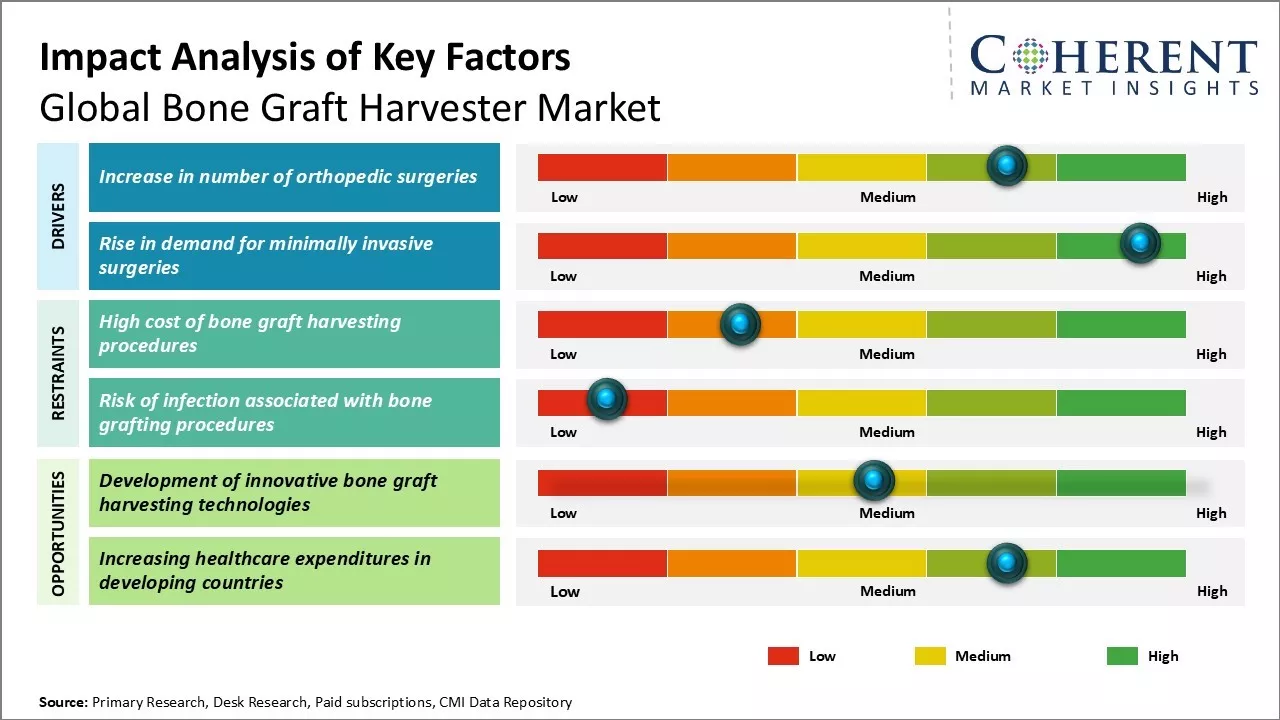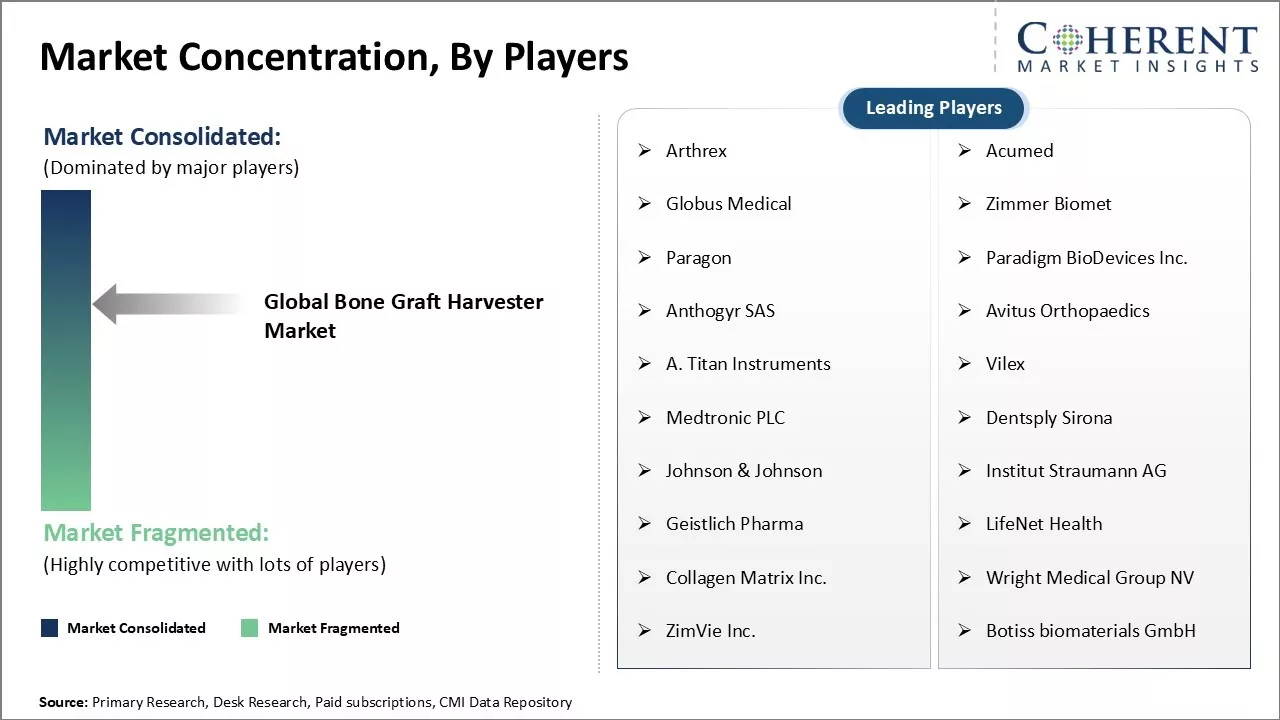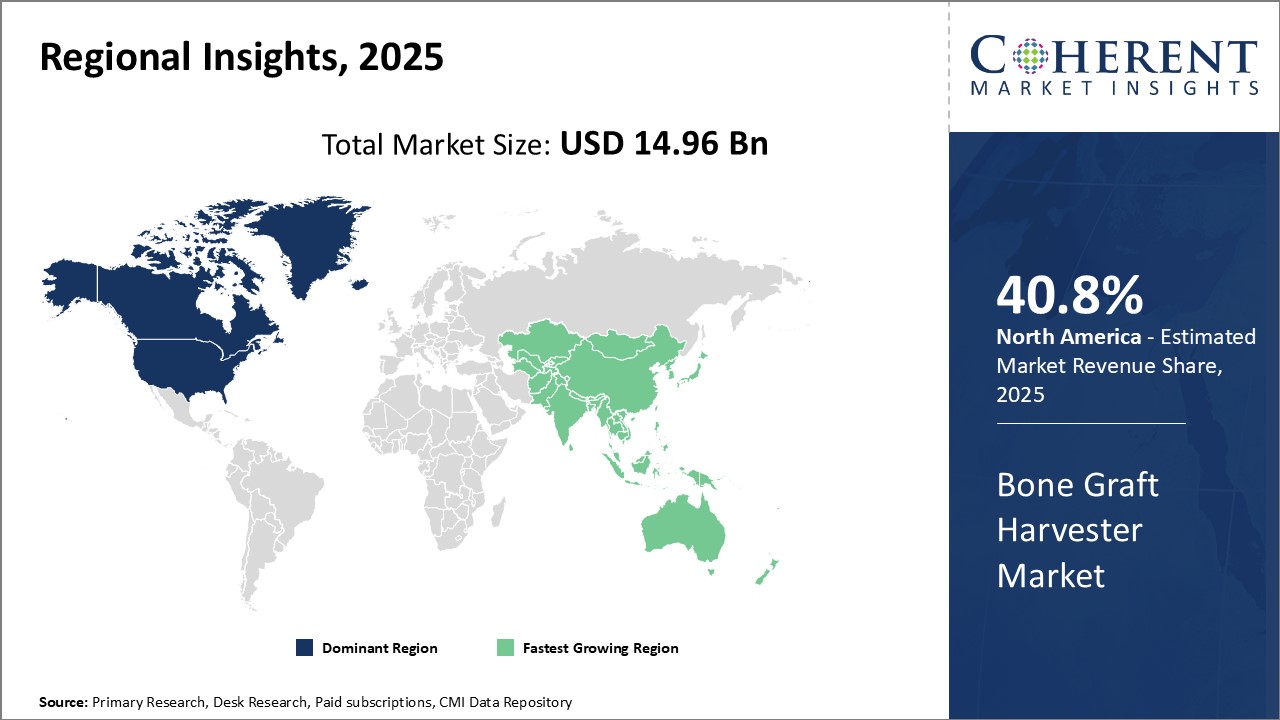Global bone graft harvester market is estimated to be valued at USD 14.96 Billion in 2025 and is expected to reach USD 22.66 Billion by 2032, exhibiting a compound annual growth rate (CAGR) of 6.1% from 2025 to 2032.

Discover market dynamics shaping the industry: Request sample copy
Bone graft harvester is an instrument intended to remove graft material from the iliac crest or other donor sites. It is used for minimally invasive harvesting of cancellous bone and/or marrow. Bone graft harvesters help obtain bone graft with minimum invasion and discomfort to patients.
Increase in number of orthopedic surgeries
Global population is ageing rapidly due to advancements in healthcare and medical technologies. Older individuals are more prone to osteoarthritis, spinal disorders, trauma injuries and other such conditions that require orthopaedic interventions. As per estimates, over 200 million people suffer from osteoarthritis globally. With rising life expectancy, there will be increase in prevalence of orthopedic conditions. This can boost demand for various joint replacement and reconstructive surgeries significantly.
Knee and hip replacements are among the most commonly performed orthopaedic procedures. According to Clinical Studies, there has been 100% rise in the number of knee and hip replacement surgeries performed in the U.S. Growing occurrence of obesity and osteoporosis increases the risks of bone fractures and failures of existing implants or prostheses. This leads to higher revision surgery rates. More individuals opt for physically demanding lifestyle and participates in sports at an older age, which increases the chances of injuries requiring surgical intervention.
All these factors lead to increase in the volume of total joint arthroplasty and other complex orthopaedic procedures. Larger number of surgeries means greater utilization of ancillary devices and consumables required for performing them successfully. Bone grafts are an indispensable part of various spinal, trauma and reconstructive orthopaedic surgeries that are used for replacing missing or damaged bones and supporting new bone tissue growth. Thus, rising surgical caseload can boost demand for improved bone graft harvesting technologies and products.

Get actionable strategies to beat competition: Request sample copy
Rise in demand for minimally invasive surgeries
Patient preferences have evolved significantly in the recent decades. Individuals want surgical treatments that allow for faster recovery times, lesser complications, minimal scarring and improved cosmetic outcomes. These people want procedures performed by skilled surgeons using advanced precision techniques. This has led to huge demand for minimally invasive surgical approaches across various medical specialties including orthopaedics.
Minimally invasive techniques for performing joint replacements, vertebral corrections and fracture fixations through smaller incisions are gaining popularity. These are known to reduce postoperative pain, blood loss, hospital stay and return patients back to normal activities sooner. The benefits have made minimally invasive procedures the preferred choice for many surgeons as well as patients. Innovation in endoscopy and computer-assisted navigation systems have enabled precise sculpting and placement of grafts, implants and devices through small access points.
There has been huge adoption of minimally invasive orthopaedic procedures across developed markets but is still at a nascent phase in developing regions. As more physicians get trained in new techniques and patients experience the outcomes of early adopters, there will be huge demand. To facilitate minimal disruption and superior visualization inside narrow operative corridors during such surgeries, special bone harvesting systems suited for Endoscopic and Arthroscopic procedures are becoming necessary. Their demand will increase in tandem with wider acceptance of minimally invasive orthopaedics worldwide.
Reliable and efficient bone graft collection technologies play a key role in enabling orthopedic surgeons to cater to evolving patient needs and deliver quality minimally invasive treatments. This leads to huge demand for bone graft harvesters designed for applications in key MI specialties.
Key Takeaways from Analyst:
Global bone graft harvester market growth is driven by increasing incidence of orthopedic surgeries worldwide. Rising geriatric population susceptible to bone-related injuries and disorders can boost demand for bone graft harvesters. Furthermore, growing number of trauma and accident cases can also drive the market growth.
North America currently dominates the bone graft harvester market due to presence of major players and advanced healthcare facilities. However, Asia Pacific is expected to be the fastest growing region due to growing medical tourism, increasing healthcare spending, and rising awareness about bone grafting procedures in the region.
High costs associated with bone graft harvesting surgeries can hamper the market growth. Alternative bone grafting options including synthetic and stem cell-based grafts can pose a threat to bone graft harvester market.
Ongoing research and development into innovative product launches can open new avenues of growth for market players. Growing partnerships between industry players and hospitals for procurement can offer market growth opportunity. New and advanced bone graft harvester designs with reduced invasiveness, faster procedures, and improved graft output can drive the market growth over the forecast period.
Market Challenges: High cost of bone graft harvesting procedures
Global bone graft harvester market growth can be hampered due to high cost associated with bone graft harvesting procedures. Bone grafting is an expensive procedure, owing to involvement of specialized medical professionals like orthopedic surgeons and other ancillary staff. Bone graft harvesters are technologically advanced medical devices that can be expensive. The costs add up further with expenses related to operating room, surgery time, hospital stay, postoperative care and rehabilitation. This makes bone grafting procedures unaffordable for a large section of patients worldwide, especially in developing economies and price sensitive markets. The exorbitant costs act as a deterrent for wider adoption of bone graft harvester devices. Device manufacturers and healthcare providers need to focus on decreasing the overall procedure costs through innovative pricing models, government intervention and reforms to make these lifesaving procedures more accessible for patients.
Market Opportunities: Development of innovative bone graft harvesting technologies
Development of innovative bone graft harvesting technologies can offer opportunities for the global bone graft harvester market players. Manufacturers are investing heavily in R&D to develop newer and more advanced technologies that can simplify harvesting procedures, minimize invasiveness, reduce operation times and costs. There is a scope to develop minimally invasive harvesters that use small incisions and cause less damage to harvest sites. Technologies allowing for less invasive graft collection from alternative donor sites like the pelvis can drive the market growth. Adoption of artificial intelligence, robotics and 3D printing can further aid in designing smart harvesters for improved graft collection capacity and yield. Emerging technologies can address current limitations and facilitate the development of personalized and patient-specific bone grafting solutions. This supports wider applications and increase the acceptance of bone graft harvesters.

Discover high revenue pocket segments and roadmap to it: Request sample copy
By Product Type - Technological advancements boosts adoption of manual bone graft harvester
In terms of product type, manual bone graft harvester segment is estimated to contribute the highest market share of 59.7% in 2025, owing to recent advancements in manual bone grafting technologies. Manual bone graft harvesters allow for a higher degree of control and tactile feedback during harvesting procedures as compared to powered devices. This greater control enables surgeons to more precisely select and extract graft particles of various sizes and densities tailored for specific bone fusion applications. Manual tools also provide haptic feedback to allow surgeons to discern differences in bone hardness and quality, assisting in evaluations of potential graft material. Furthermore, manual harvesters require lower capital investments and maintenance costs as compared to powered devices. This makes them an attractive option for resource-constrained healthcare facilities.
By Technique - Minimally invasive techniques dominates
In terms of technique, minimally invasive techniques segment is estimated to contribute the highest market share of 39.7% in 2025, owing to increasing demand for less traumatic harvesting methods. Minimally invasive techniques such as endoscopic and percutaneous approaches reduce surgical trauma, speed up recovery times, lessen risks of infections and minimize scarring as compared to open harvesting techniques. These allow for the collection of autogenous grafts while causing minimal damage to soft tissues and neurovascular structures. This results in less postoperative pain and quicker return to normal activities for patients. Widespread physician training and new technologically advanced graft collection tools have enhanced the availability and viability of minimally invasive bone grafting options.
By Application - Mounting spinal fusion volume boosts spinal fusion segment growth
In terms of application, spinal fusion segment is estimated to contribute the highest market share of 51.5% in 2025, due to rising incidence of spinal disorders globally. Spinal fusion is a commonly performed orthopedic procedure that is used to treat herniated discs, degenerative disc disease and spinal stenosis. It promotes bone growth and eliminates motion between adjacent vertebrae. With rapidly aging populations and growing prevalence of obesity worldwide, there has been increase in volume of spinal surgeries especially lumbar and cervical fusion procedures. This increasing spinal fusion rate directly boosts demand for bone grafting, and hence harvesters, as autogenous bone grafts remain the gold standard for achieving robust fusion.

Need a Different Region or Segment? Customize now
North America dominates the global bone graft harvester market with an estimated market share of 40.8% in 2025, owing to strong presence of key market players and established healthcare infrastructure in the region. The U.S. accounts for the largest share in the North America market due to high adoption of advanced medical technologies and presence of numerous surgeries requiring bone grafting procedures. Favorable reimbursement policies for surgical procedures and strong funding for medical research and development activities can drive the market growth in North America.
Asia Pacific region has emerged as the fastest growing market for bone graft harvester. Rapidly developing healthcare infrastructure, growing medical tourism industry and rising healthcare expenditure can drive the Asia Pacific bone graft harvester market growth. Moreover, increasing awareness about advanced treatment options and rising geriatric population undergoing joint replacement surgeries boosts demand for bone grafting procedures in the region. Countries like China, Japan and India have been at the forefront and are expected to contribute significantly to growth of Asia Pacific bone graft harvester market. Rising disposable incomes have made costlier treatment options more affordable for people in the region. This has encouraged adoption of advanced medical devices like bone graft harvesters.
Among key players, Japan based Smith & Nephew has significant presence Asia Pacific region through its direct sales operations and a wide distribution network. The company has been focusing on strengthening its foothold in high potential Asian countries. Given growing middle-class population with greater access to healthcare in Asia, numerous global as well as regional players have started exploring opportunities in the region. This has intensified competition and induced new product launches with advanced features catering to clinical as well as pricing requirements of the region.
Bone Graft Harvester Market Report Coverage
| Report Coverage | Details | ||
|---|---|---|---|
| Base Year: | 2024 | Market Size in 2025: | USD 14.96 Bn |
| Historical Data for: | 2020 To 2024 | Forecast Period: | 2025 To 2032 |
| Forecast Period 2025 to 2032 CAGR: | 6.1% | 2032 Value Projection: | USD 22.66 Bn |
| Geographies covered: |
|
||
| Segments covered: |
|
||
| Companies covered: |
Arthrex, Acumed, Globus Medical, Zimmer Biomet, Paragon, Paradigm BioDevices Inc., Anthogyr SAS, Avitus Orthopaedics, A. Titan Instruments, Vilex, Medtronic PLC, Dentsply Sirona, Johnson & Johnson, Institut Straumann AG, Geistlich Pharma, LifeNet Health, Collagen Matrix Inc., Wright Medical Group NV, ZimVie Inc., Botiss biomaterials GmbH |
||
| Growth Drivers: |
|
||
| Restraints & Challenges: |
|
||
Uncover macros and micros vetted on 75+ parameters: Get instant access to report
*Definition: Global bone graft harvester market involves surgical devices and instruments used for harvesting and collecting bone graft material from one part of the patient's body (like hip or pelvis) to another part (like spine) during orthopedic surgical procedures. Bone graft harvesters help surgeons efficiently collect autologous bone grafts with minimal invasiveness and discomfort for the patient. These contain sharps or blades to procure bone fragments which are then stored in collectors for use as grafts material during fusion or reconstruction surgeries.
Share
Share
About Author
Manisha Vibhute is a consultant with over 5 years of experience in market research and consulting. With a strong understanding of market dynamics, Manisha assists clients in developing effective market access strategies. She helps medical device companies navigate pricing, reimbursement, and regulatory pathways to ensure successful product launches.
Missing comfort of reading report in your local language? Find your preferred language :
Transform your Strategy with Exclusive Trending Reports :
Frequently Asked Questions
Joining thousands of companies around the world committed to making the Excellent Business Solutions.
View All Our Clients
US Reciprocal Tax Impact Analysis On Bone Graft Harvester Market
Stay updated on tariff changes with expert insights and timely information